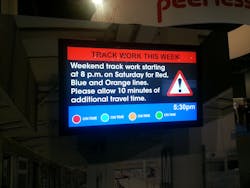Technology Makes Transit the Next Frontier for Digital Signage Innovators
Walking around the 2014 Digital Signage Expo, it’s pretty easy to see who a lot of the companies are targeting with their products.
Booth after booth has electronic menu boards for restaurants. Salesmen and engineers tout the abilities of the signs to boost sales in retail and restaurant environments and how customers can interact with the products to get a better connection with brands.
But the technology has evolved to much more than sharp, crystal clear signs and chic animation meant to entice customers to come in and buy products. The products are becoming more interactive and providing a depth of engagement never seen before with users that can create whole new levels of success for signs.
And with this new technology more companies are opening their sales boarders and looking to burst into the world of transit and offer agencies the same level of engagement private companies offer their customers.
One example is a new product by Capital Networks that allows users to engage digital signage with their smart phones and actually take information with them on the fly. Bus or train riders could see an advertisement on a vehicle or in a station, then tap their phone and collect a customized deal for them. Not to mention that if a rider wanted to take a bus or train schedule or map with them all they would need to do is approach a station kiosk, tap their phone and the map would be automatically downloaded for them to take with.
In a world where smartphone payment for transit is starting to take off, this technology could be a huge boom for transit riders.
Then there’s companies like SurgeX who see the potential in the transit market and are now trying to break into the market to assist agencies with their move to digital signage by providing surge protection to protect pricy signage investments. The company provides surge protection for most major sports venues and when I met with one of their vice presidents at DSE, he mentioned how they’ve realized their product would be a great fit for subways where power surges are commonplace.
And when it comes to the signs themselves, E Ink is mounting its push into transit with signs that could make signage more affordable for many agencies. The makers of the technology that many people may associate with their Kindle display, E Ink is working with GDS Displays to provide signage for transit agencies. What makes this technology exciting is that is uses very low voltage to operate as opposed to LED displays and it also weighs much less than traditional signs. That means next bus signs or digital advertisements can be hung at bus shelters and powered only by solar panels. No trench digging, no special hanging equipment. Just plug it in and let the solar panels power it.
Much like the transit industry, digital signage has evolved greatly in recent years and is more engaged with end users than ever before. Hopefully with these new technologies finally reaching the market and a newfound push to implement them in transit means both industries can use them to enhance their services in ways only dreamed about before.

Joe Petrie | Associate Editor
I came to Mass Transit in 2013 after spending seven years on the daily newsbeat in southeastern Wisconsin.
Based in Milwaukee, I worked as a daily newspaper reporter with the Waukesha Freeman from 2006-2011, where I covered education, county and state government. I went on to cover courts for Patch.com, where I was the main courts reporter in the Metro Milwaukee cluster of websites.
I’ve won multiple awards during the course of my career and have covered some of the biggest political events in the past decade and have appeared on national programs.
Having covered local government and social issues, I discovered the importance of transit and the impact it can have on communities when implemented, supported and funded.


